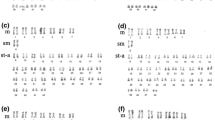Abstract
A biotinylated 28S rDNA probe was prepared from the genomic DNA of the Antarctic ice-fishChampsocephalus gunnari and hybridized to metaphase chromosomes of the same species by fluorescencein situ hybridization (FISH). The hybridization signal appeared over the whole heterochromatic arm of the submetacentric chromosomes bearing the nucleolar organizer regions. The results of rDNA/FISH are compared with those coming from classical cytogenetic (C, Q, Ag-NOR, chromomycin A3) banding techniques. Thein situ detection of a specific DNA sequence offers a new more precise perspective for understanding the evolving process in chromosomes of Antarctic fish and will provide an interesting contribution to comparative cytogenetics of lower vertebrates.
Similar content being viewed by others
References
Carman O, Matsuda T, Oshiro T, Takashima F (1993) Mapping of rDNA genes (NOR) in carp chromosomes using the cloned probe of mouse rDNA by FISH analysis.Nippon Suisan gakkaishi 59: 729.
Caspersson T, Zech L, Johannson C, Modest EJ (1970) Identification of human chromosomes by DNA-binding fluorescent agents.Chromosoma 30; 215–277.
de Lucchini S, Andronico F, Andreazzoli M, Giuliani M, Savino R, Nardi I (1988) Extra-ribosomal spacer sequences inTriturus.J Mol Biol 204: 805–813.
Doussau de Bazignan M, Ozouf-Costaz C (1985) Une technique rapide d'analyse chromosomique appliquée à sept espèces de poissons antarctiques.Cybium 9: 57–74.
Duhamel G Hureau JC (1990) Changes in fish populations and fisheries around the Kerguelen Islands during the last decade. In: Kerry KR, Hempel G. eds.Antarctic Ecosystems. Change and Conservation Berlin: Springer, pp. 323–333.
Eastman JT (1993),Antarctic Fish Biology: Evolution in a Unique Environment. San Diego: Academic Press.
Foresti, F, Almeida Toledo LF, Toledo SA. (1981) Polymorphic nature of nucleolus organizer regions in fishes.Cytogenet Cell Genet 31: 137–144.
Gon O, Heemstra PC (1990)Fishes of the Southern Ocean. Grahamstown, South Africa: J.L.B. Smith Institute of Ichthyology.
Harltey SE, Horne MT (1985) Cytogenetic techniques in fish genetics.J Fish Biol 26: 575–582.
Hassouna N, Michot B, Bachellerie JP (1984) The complete nucleotide sequence of mouse 28S rDNA gene. Implications for the process of size increase of the large subunit rDNA in higher eukaryotes.Nucleic Acids Res 12: 3563–3583.
Howell WM, Black DA (1980) Controlled silver-staining of nucleolus organizer regions with a protective colloidal developer: a 1-step method.Experientia 36: 1014–1015.
Kock KH (1992)Antarctic Fish and Fisheries. Cambridge: Cambridge University Press.
Le HLV, Lecointre G, Perasso R (1993) A 28S rRNA-based phylogeny of the Gnathostomes: first step in the analysis of conflict and congruence with morphologically based cladograms.Mol Phyl Evol 2: 35–51.
Morescalchi A, Pisano E, Stanyon R, Morescalchi MA (1992a) Cytotaxonomy of Antarctic teleosts of thePagothenia/Trematomus complex (Nototheniidae, Perciformes).Polar Biol 12: 553–558.
Morescalchi A, Hureau J-C, Ozouf-Costaz C, Pisano E, Stanyon R (1992b) A multiple sex-chromosome system in Antarctic ice-fishes.Polar Biol:11: 655–661.
Ozouf-Costaz C, Doussau de Bazingnan M (1987) Chromosome relationships among 15 species of Nototheniidae. In: Kullander SO, Fernholm B, eds.Fifth Congress of European Ichthyologists, Proceedings, Stockholm, 1985. Stockholm: Swedish Museum of Natural History, pp 413–419.
Ozouf-Costaz C, Hureau J-C, Beaunier M (1991) Chromosome studies on fish of the suborder Notothenioidei collected in the Weddell Sea during EPOS 3 cruise.Cybium,15: 271–289.
Pendas AM, Moran P, Garcia-Vazquez E (1993) Multi-chromosomal location of ribosomal RNA genes and heterochromatin association in brown trout.Chrom Res 1: 63–67.
Pendas AM, Moran P, Garcia-Vazquez E (1994) Ribosomal genes are interspersed throughout a heterochromatic chromosomal arm in Atlantic salmon.Cytogenet Cell Genet 67: 31–36.
Pisano E, Ozouf-Costaz C, Hureau J-C, Williams R (1995) Chromosome differentiation in the subantarctic Bovichtidae speciesCottoperca gobio (Gunther, 1861) andPseudaphritis urvillii (Valcienne, 1832) (Pisces, Perciformes).Antarct Sci 7: 381–386.
Pisano E, Ozouf-Costaz C, Bonillo C, Caimo A, Rossetti S, Williams R (1996) Cytogenetics of the antartic icefishChampsocephalus gunnari Lönnberg, 1905 (Channichthyidae, Notothenioidei).Comparative Biochemistry and Physiology. (in press)
Prirodina VP (1994) Review of karyotypic and taxonomic diversity in the suborder Notothenioidei.J Ichthyol 34(6): 1–13.
Schmidtke J, Zences MT, Weiler C, Bross K, Engel W (1976) Gene action in fish of tetraploid origin. IV. Ribosomal DNA amount in Clupeoid and Salmonoid fish.Biochem Genet 14: 293–297.
Schweizer D (1976) Reverse fluorescent chromosome banding with chromomicyn and DAPI.Chromosoma 58: 307–324.
Sola L, Monaco PJ, Rasch EM (1990) Cytogenetics of bisexual/unisexual species ofPoecilia. I. C-bands, Ag-NOR polymorphisms, and sex chromosomes in three populations ofPoecilia latipinna.Cytogenet Cell Genet 53: 148–154.
Sumner (1972) A simple technique for demonstrating centromeric heterochromatin.Exp Cell Res 75: 304–306.
Sumner AT (1992)Chromosome Banding. London: Unwin Hyman.
Vitturi R, Mazzola A, Catalano E, Lo Conte MR (1990) Karyotype analysis, nucleolar organizer regions (NORs) and C-banding pattern ofDicentrarchus labrax (L.) andDicentrarchus punctatus (Block, 1792) (Pisces, Perciformes) with evidence of chromosomal structural polymorphism.Cytologia 55: 425–430.
Williams R, de la Mare WK (1995)Fish Distribution and Biomass in the Heard Island Zone (Division 58.5.2). Working Document WG-FSA-94/10, 32 pp. (mimeogr). Hobart: CCAMLR.
Williams R, Smolenski AJ, White RWG (1994) Mitochondrial DNA variation ofChampsocephalus gunnari Lönnberg (Pisces: Channichthyidae) stocks on the Kerguelen Plateau, Southern Indian Ocean.Antarct Sci 6: 347–352.
Winnepennickx B, Backeljau T, de Wachter R (1993) Extraction of high molecular weight DNA from molluscs.Trends Genet 9(12): 407.
Author information
Authors and Affiliations
Corresponding author
Additional information
accepted for publication by M. Schmid
Rights and permissions
About this article
Cite this article
Ozouf-Costaz, C., Pisano, E., Bonillo, C. et al. Ribosomal RNA location in the Antarctic fishChampsocephalus gunnari (Notothenioidei, Channichthyidae) using banding and fluorescencein situ hybridization. Chromosome Res 4, 557–561 (1996). https://doi.org/10.1007/BF02261718
Received:
Revised:
Accepted:
Issue Date:
DOI: https://doi.org/10.1007/BF02261718




